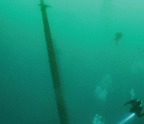The Tug, Tacoma

Tugboats are the energetic workhorses of maritime communities, engaging in activities ranging from towing log booms or rafts, sometimes great distances, upon the vast Great Lakes (see “Workhorse in the Wilderness” in WDM #38) and pulling larger vessels carefully into or out of narrow or crowded harbors, to hauling dredges and barges filled with bulk items such as sand, stone, or garbage.
The earliest record of a tugboat working at Chicago on Lake Michigan appeared in 1849, when the small sidewheel paddle steamer named the Archimedes was built there. But it was not its short length (62 feet, or 18.8 metres) that made it unsuitable as a tug, but rather the fact that it was a paddlewheel design that fared well in neither maneuverability nor in the rougher, open waters of Lake Michigan. For whatever reason(s), this boat was abandoned at Chicago in 1856, one of the first of a long line of vessels similarly forsaken there.
Chicago was growing quickly in the 1850s – the population increased from 30,000 in 1850 to over 112,000 in 1860 -- and tugboats became an absolute necessity for assisting Chicago’s bustling maritime mobility, the chief driving force behind the city’s expansion. With increasing numbers of tugboats over a long period of time came wrecked and abandoned tugs.
Several unidentified tugboat shipwrecks lie off Chicago. The nicknamed “East Tug” sits in 45 feet (13.5 metres) of water about one mile (1.6 kilometres) east of Chicago’s Four- Mile Crib. The 60-foot-long (18-metre) “South Tug,” at the same depth of water, features its engine, boiler, and propeller, along with scattered pottery pieces. The nearby 70-foot-long (21-metre) “North Tug”
You’re reading a preview, subscribe to read more.
Start your free 30 days



